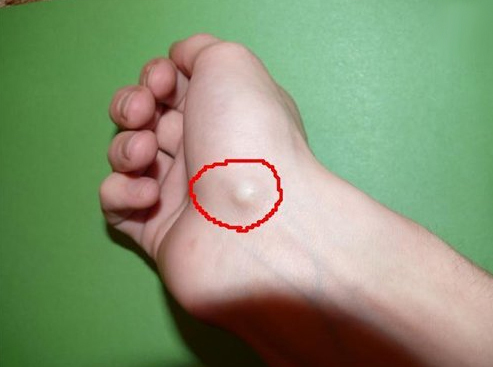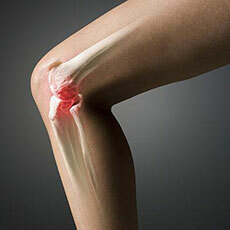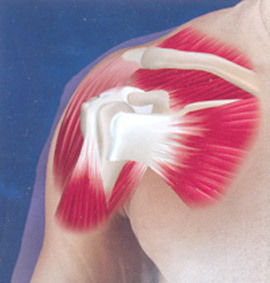The reason for the appearance of hygroma is the patient's disease with bursitis or tenosynovitis. Possible cause of the formation of the hygroma may be injury to the synovial bag or tendon sheath associated with occupational activities.
Hygroma brush usually begins to grow in the tissues of the joints. The process of appearance of the tumor is due to various reasons:
- excessive physical exertion;
- injury.
Most often, the hygroma on the arm is formed from the back of the hand, however, it may appear on the flexor muscles of the fingers( finger hygroma) or on the inner half of the wrist joint.
The hygroma of the wrist interferes with the normal operation of the joints and causes severe pain. For this reason, it requires urgent surgical intervention.
Hygroma joint is a relatively painless tumor resembling cystic formation. When such a tumor develops, the extensor and flexion movements are violated. This prevents you from making habitual movements and leading a habitual way of life.
Hygroma of wrist joint can appear in connection with monotonous movements and overstrain of the muscular group of hands. Usually, computer operators and pianists suffer most from this hygroma. Outwardly it resembles a painless tumor up to several centimeters in diameter. A small hygroma delivers a painful sensation only when the wrist is heavily loaded or bent.
The hygroma of the foot is formed, as a rule, in the ankle or on the outside of phalanal bones. Hygroma stops prevents wearing of shoes and walking. There is the possibility of injury( for example, boots), an increase in size, which leads to the squeezing of nearby nerve endings and vessels. In this case, there is an acute pain syndrome. When the tumor is injured, an inflammatory process begins, so the hygroma on the leg is immediately removed before the pathological exacerbation has begun.
Hygroma of the knee has received the same wide distribution as the hygroma of the brush. This tumor is usually caused by an excessive amount of fluid located in the cavities of the synovial bag, which occurs due to overstrain or trauma to the knee joint. Hygroma of the knee joint often accompanies those who spend their free time on their feet. They can be: sellers;athletes;couriers and many others.
The hyposomolar popliteal usually appears due to muscle stasis or overexertion. Her appearance most of all interferes with the flexural movements of the foot. Most often, it accompanies people of the same professions, as with gigroma of the knee joint. Developed hygroma popliteal fossa prevents walking, so it is subject to immediate and mandatory removal.
The hygroma of the tendon is referred to as the location of the hygroma. Usually, this hygroma begins to develop against the background of bursitis( defeat of the joint bag) or tendovaginitis( damage to the tendon sheath).If the tumor grows against a background of tendovaginitis, talk about the sinus tendon.
The brain hygrometer can be represented by two types: subdural and intradural. Subdural hygroma is characterized by the accumulation of cerebrospinal fluid in the subdural region of the brain. Intradural hygroma is characterized by the accumulation of cerebrospinal fluid in the space between the sheets of the hard shell of the brain.
The hygroma of the neck usually appears in newborns on the lateral surface of the neck, consisting of several cysts. It extends in the direction of the axilla or in the direction of the mediastinum. Most often, this tumor is present at the birth of the baby, but sometimes it can occur in infancy or even later. In the course of childbirth or afterwards, severe complications can occur in the form of compression of the trachea or vessels of the neck. If necessary, the operation is carried out immediately, and if there is no threat to the health of the child, it can be transferred to a later period.
The cystic hygroma of the fetal neck refers to disorders in the formation of the lymphatic system, known as "fetal lymphangioma."Lymphangioma is included in the category of benign tumors. The most common lymphangioma is located on the back of the neck and is called the "cystic neck hygroma".
Hygroma in children is formed during the period of uterine or posttractive development. The reasons for the formation of a tumor can be either too high a child's mobility, or its reduced activity. If necessary, the removal of this unpleasant formation in a child can be carried out under general anesthesia( if the baby is less than 10 years old), or under local anesthesia.
Symptoms of hygroma
The hygroma is probed as a dense, elastic globular tumor with an even surface. The tumor is immobile, since its base is securely attached to nearby tissues or to the bones of the skeleton.
Sometimes under the skin can be palpated rice bodies with high mobility and well-expressed fluctuations. A tumor on palpation does not cause pain. The temperature is usually kept within normal limits.
The disease can be chronic with exacerbations and the appearance of prolonged severe pain.
At the first time of its development the hygroma can not cause concern, slowly increasing in size.
As they grow,
- starts to appear rounded up to five centimeters in diameter;
- the surface of the formations is smooth and soft elastic;
- when squeezing or moving in the joints and tendons there is a drawing pain;
- skin over hygroma slightly thickened and rough;
- the skin reddens in inflammatory processes.
Treatment of hygroma
Many years of experience in the treatment of this disease shows that conservative treatment shows its non-reflexivity. The vast majority of the treatment courses produced negative results and resulted in relapses. How can you cure a hygromist?
Crushing hygroma - is the most painful treatment for .
In this procedure, the stored fluid is pressed into the joint cavity and spreads around the surrounding tissues. The tumor envelope is torn, however, over time, it restores the lost tightness and the hygroma appears again. In addition, after trauma to the skin can begin an inflammatory purulent process.
Conducting the punctuation of the hygroma.
From the tumor, the syringe is sucked into its contents and various medicinal substances are injected into it. After such a procedure, the hygroma temporarily resolves, but the shell remains in place, and the pumped out fluid sooner or later begins to accumulate again.
Surgical treatment of hygroma with complete excision of the ganglion - is the most effective surgical tumor treatment.
Carrying out this operation guarantees complete relapse of the relapse. The operation to remove the hygroma is performed under local anesthesia for about 30 minutes. After the operation, the stitches are usually removed after a week. The large size and complex localization of the hygroma serves as an indication for the operation under general anesthesia.
However, you should beware when you are told that the operation is trivial and will not take more than five minutes. The tumor after the operation must disappear forever. Remove the hygroma from the surrounding tissues is necessary until complete isolation, otherwise relapse can not be avoided. The operation to remove the hygroma is quite painstaking and delicate.
Removal of the hygroma of the brush in modern medicine is represented in three ways: conservative( opening of the hygroma with further treatment with medical products);surgical( complete excision of the hygroma as a result of the operation);Laser( heating hygromes until it is completely destroyed).
Treatment of hygroma of wrist joint by any of the presented methods is performed under local anesthesia. It is impossible to single out any one technique: only a doctor will be able to choose this or that method depending on each specific case.
The price of carrying out manipulations with hygroma can vary significantly depending on the size of the hygroma.
So, one procedure for conservative treatment costs about 1500 rubles. Surgical or laser removal of hygroma will cost you from 3000 to 6000 rubles. Of course, prices are very approximate, since in each medical center they can vary significantly.
Treatment of hygroma with folk remedies
The folk hygroma treatment offers us many different recipes. Here are some of them.
Copper plate.
Take a small copper plate( slightly more hygroma) and burn it on fire. Then it is necessary to wash the plate in a concentrated saline solution and attach the plate, carefully pribintovat, to gigroma for three days. After three days, remove the plate, calcine, rinse with salt solution and apply again to gigroma.
Napkin in the urine.
Take a napkin from a clean plain cloth, moisten it in your urine and attach it to the gigroma. Cover the top with cellophane and woolen scarf. Leave it overnight.
Cabbage juice.
Fresh white cabbage must be scrolled through a meat grinder. The resulting mass squeeze through the cheesecloth, and drink the juice before eating. For a day you need to drink a glass of juice. The course of treatment is a month.
Cabbage with honey.
Take the cabbage leaf, smear it with honey and apply to gigroma, like a compress. Leave the compress on overnight.
Jellyfish.
Positive effect is provided by pieces from the body of jellyfish, bandaged as a compress.
Tea mushroom.
Has the same effect as the previous compress, but pieces of jellyfish should be replaced with pieces of a tea mushroom.
Alcohol.
Put gadgets with medical alcohol( 70%).Cover the top with cellophane and a warm towel. The procedure should be carried out at night.
Aloe with honey.
Take honey and aloe juice in the same proportions, knead with rye flour until a soft cake is received. Pellet to apply to gigroma at night. Shvrhu cover with cellophane and tie a warm towel or handkerchief.
 Hygroma is a focal congestion of serous fluid in the open cavities of joints and tendons.
Hygroma is a focal congestion of serous fluid in the open cavities of joints and tendons.



